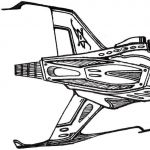 NASA has always been in the forefront of ground breaking technology for many years now, and they are not slowing down anytime soon. Even as the United States economy has shrunk the budget of the agency, it has not let this challenge to get in the way of progress. NASAs missions include various trips into space and specifically the Russian controlled space station. Ever since the agency came into existence, they have focused on astronaut safety before anything else. The value of life amongst the agency is high, and no mission’s goal precedes it. There have been accidents in the past where brave astronauts have lost their lives. We have even seen instances where civilians on missions have lost their lives like in the case of shuttle Columbia. In order to maintain the health of its astronauts, the agency strives to both develop and adopt technology that helps it monitor the health of its astronauts.
NASA has always been in the forefront of ground breaking technology for many years now, and they are not slowing down anytime soon. Even as the United States economy has shrunk the budget of the agency, it has not let this challenge to get in the way of progress. NASAs missions include various trips into space and specifically the Russian controlled space station. Ever since the agency came into existence, they have focused on astronaut safety before anything else. The value of life amongst the agency is high, and no mission’s goal precedes it. There have been accidents in the past where brave astronauts have lost their lives. We have even seen instances where civilians on missions have lost their lives like in the case of shuttle Columbia. In order to maintain the health of its astronauts, the agency strives to both develop and adopt technology that helps it monitor the health of its astronauts.
Related Coverage
Pulse Oximeter Used In Aviation
Pilots have known the need for monitoring this oxygen levels for almost a hundred years now. As aircraft climb in altitude, the oxygen levels drop. This is a very dangerous effect if not counteracted. NASA astronaut at a travel conference in Bulgaria
eCommerceAcademy.net launches ‘Trends & Innovation Travel Distribution & Investment Summit’ March 15-17, 2011 at the Sheraton Hotel, Sofia Bulgaria! Tourists in Space By 2015!
Space travel, before everything that man has achieved now, was a far-fetched notion and impossible to achieve. The space is a great distance away from humans that it can only be observed through the telescope. However, the mind is an amazing creation, and with it everything became possible. Who would have thought that the once unreachable space can now be a possible place for tourists to visit? Space Tourism
Do you think you’ve already seen everything on our planet? And traveling even to the remotest parts of our world doesn’t excite you anymore, and then space tourism is the way to go for you. No, I’m not kidding, space tourism is an option increasingly being chosen by travelers. The only drawback is that they are somewhat unique in terms of costs involved and timing. Many people believe that buying tickets to travel to space and back is a futuristic idea and still only a concept. This is partly true, but through the last decade, huge amounts of work have gone into realization of this concept. The monitoring of various vital signs provides mission specialists a direct view of the conditions experienced by the astronauts, and any challenges that they may be encountering. Some of these challenges might not even be known to the astronauts, but mission control is always one step ahead whenever possible.
A recent tool that has been adopted into NASA and its various missions is the pulse oximeter. A pulse oximeter, also known as a pulse ox by some medical professionals, is a medical device used to measure the blood oxygen saturation and pulse rate of individuals. These are important factors of the human body, because they provide data that can be used to determine how efficient the lungs and heart are at any given point of time.
In the past a pulse oximeter was a bulky tabletop unit only seen in clinical settings, but with recent advances in technology all that has drastically changed. A new fingertip pulse oximeter is smaller than most cell phones, and runs on standard batteries. NASA is working on using a finger oximeter to develop a device that is the same size, but transmit its data to mission specialists via intermediate hardware and software. NASA is also going to adapt on their pulse oximeter to withstand harsher conditions that are not present here on Earth. Variances in temperature and pressure are big factors to consider when creating products to be used in space.
A pulse oximeter has again proven its ability as a necessary tool for the monitoring of health conditions of patients.
Nasa Adapts Pulse Oximeter Technology For Space Travel
Vows To Advance In Space
 NASA on Friday said fear of failure should not hold back its mission to test the boundaries of human space exploration, as the agency marked the 25th anniversary of the Challenger disaster. Seven crew members died aboard Challenger on January 28, 1986, when a booster rocket failed 73 seconds after liftoff, triggering an explosion of the space shuttles fuel tank.
NASA on Friday said fear of failure should not hold back its mission to test the boundaries of human space exploration, as the agency marked the 25th anniversary of the Challenger disaster. Seven crew members died aboard Challenger on January 28, 1986, when a booster rocket failed 73 seconds after liftoff, triggering an explosion of the space shuttles fuel tank.
We who remain on the ground and asked them to fly failed them that day, as we would fail the crew of Columbia 17 years later and as we failed the crew of Apollo 1 19 years before, said Bill Gerstenmaier, who now oversees NASAs human space flight programs. We can’t let the fear of failure stop us, he said. The team has learned tremendous lessons from these events, Gerstenmaier vertical roller mill told a crowd of about 250 gathered at Kennedy Space Centers Space Mirror Memorial. Their sacrifice was a stark, brutal reminder that our knowledge, our technology, our science and our dreams are often paid for in the dearest possible way, Gerstenmaier said. This has been the case throughout human history and will be the case as long as we are willing to push the boundaries of our capabilities toward destinations of which we can only dream, he said.
The U.S.
Related Coverage
Helpful tips to get your creativity going when trying to come up with your wedding vows. Dukang Normalized Vows Henan Liquor Top Three
If you want to hold a vow renewal ceremony as an anniversary celebration, you should choose what type of ceremony you want, pick a date, pick a venue for the event, determine who will be the officiant of the celebration, and hand out your invitations.space agency will be retiring its three remaining space shuttles within about six months primarily due to high operating costs and to free up funds to develop spaceships that can travel farther than the vertical roller mill International Space Station, which orbits about 220 miles above Earth. The Obama administration and Congress, however, have not yet finalized plans and allocated funding for follow-on work.
June Scobee Rodgers, whose husband, Francis Dick Scobee, was the Challenger crew commander, said that just as the accident was a transition in the shuttle program, the retirement of the fleet is not the end of human space flight, but the beginning of a new chapter. Its time for the next 25 years to unfold, said Rodgers, who spearheaded a drive to create a network of education centers vertical roller mill as a living memorial to the Challenger crew, which included, for the first time, a school teacher, Christa McAuliffe.
If we didn’t somehow continue Challengers mission then our loved ones would have died in vain, Rodgers said.
There are now 48 branches of the Challenger Center for Space Science Education in the United States, Canada, South Korea and the United Kingdom. Achieving great things sometimes comes at great cost, President vertical roller mill Barack Obama said in a statement commemorating the Challenger, Columbia and Apollo 1 accidents. Despite the challenges before us today, let us commit ourselves and continue their valiant journey toward a more vibrant and secure future.
In addition to Scobee and McAuliffe, the Challenger crew included Michael Smith, Ronald McNair, Judith Resnik, Ellison Onizuka and Gregory Bruce Jarvis.
The Columbia crew commander Rick Husband, pilot William McCool and astronauts Kalpana Chawla, Laurel Clark, Michael Anderson, David Brown and Israels Ilan Ramon died on February 1, 2003, when their ships heat shield vertical roller mill failed as they flew through the atmosphere for landing. Apollo astronauts Virgil Gus Grissom, Roger Chaffee and Edward White died on January 27, 1967, when a fire broke out in their capsule during a prelaunch test.